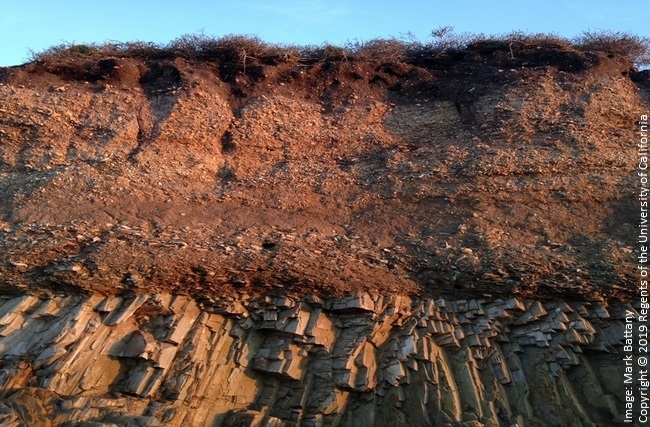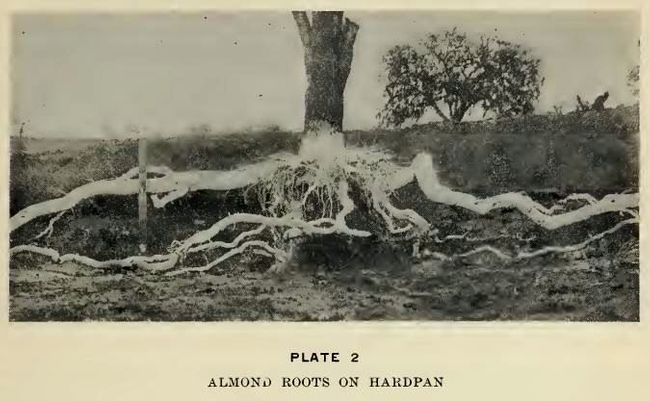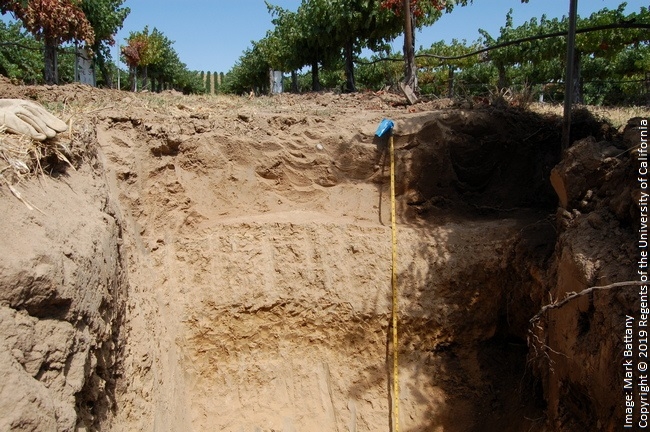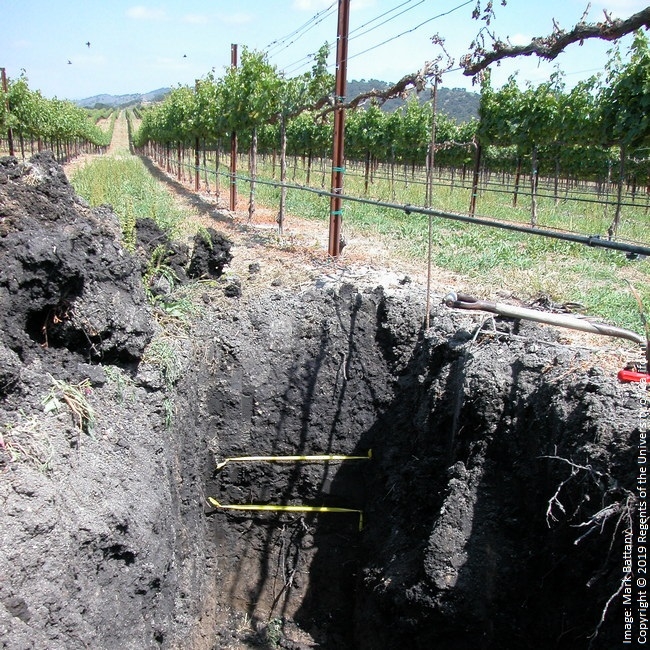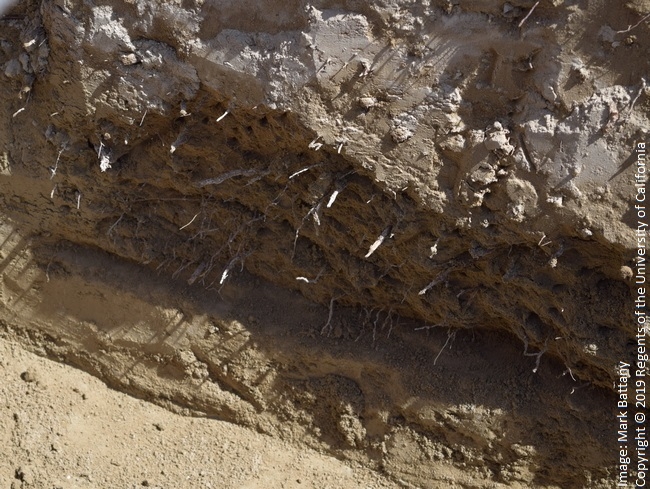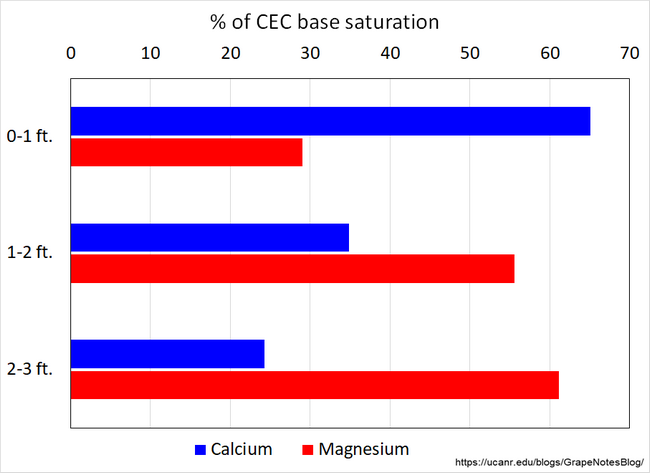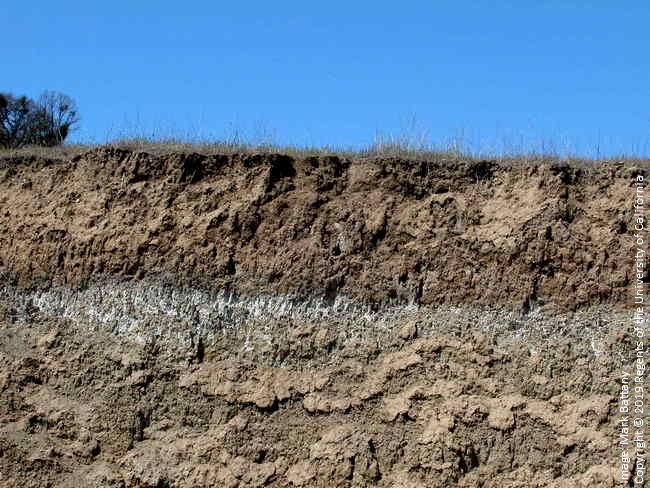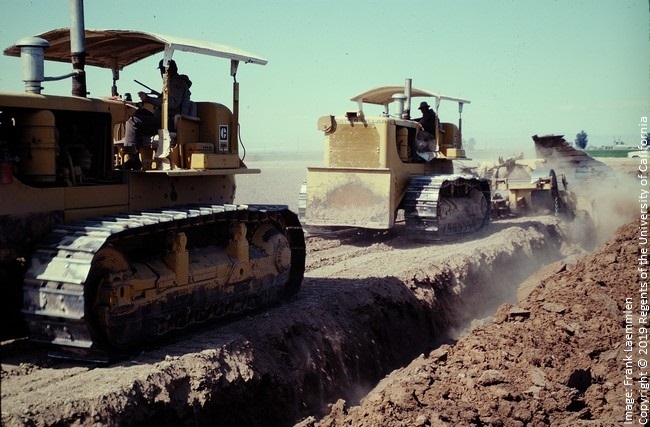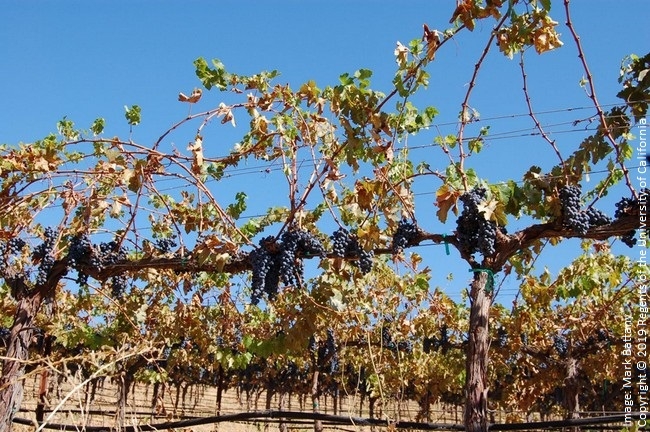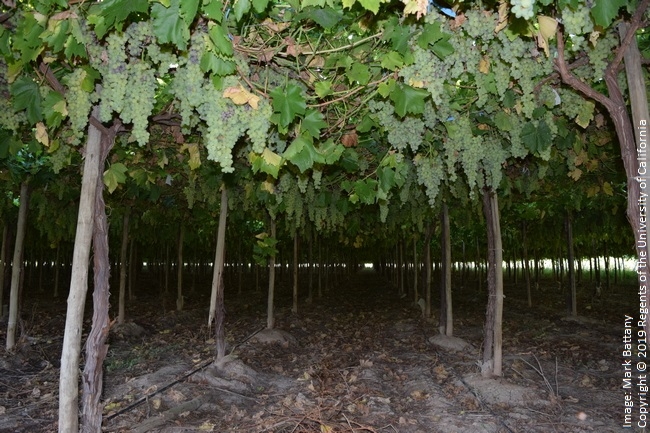Irrigation frequency and volume
One fundamental decision that a grower needs to make is how frequently to irrigate a vineyard; either applying small amounts of water frequently, or larger amounts of water less frequently. This choice determines how large the soil "flower pot" is that supports the vines, while also having implications for nutrient availability, salinity conditions and potential limitations on water infiltration. Changing from frequent small irrigations to infrequent large irrigations, either as an ongoing practice or as a one-time event, may lead to unanticipated outcomes and thus should ideally be done after ensuring that the conditions are adequate for this practice. For this reason it can be beneficial to evaluate the soil and water quality conditions at a site before making large changes in irrigation practices. Factors to consider include the potential depth of the rootzone, the presence of any layers in the soil which may cause infiltration problems, the salinity of the irrigation water, and the potential nutrient conditions affected by changing the wetted soil volume.
Root zone depth
If applying a large volume of irrigation water, the soil needs to have the capacity to store this water while providing adequate porosity conditions allowing gas exchange for proper root function. The soil depth to bedrock needs to be considered; if this depth is shallow in areas of the vineyard, this can lead to poor performance with large irrigations if they result in ponded water above the bedrock or large variations in total available soil water due to varying soil depths.
Most of our vineyards are located on deeper alluvial soils where shallow bedrock is not a concern. For a given rooting depth, finer-textured soils with their relatively high water holding capacity can store more water and thus be irrigated with larger volumes less frequently, while coarse-textured soils with their lower water holding capacity generally need to be irrigated with smaller amounts more frequently. Grapevine roots can grow very deeply in the soil, more so if that is where available water is found; however a vine which has developed mostly shallow roots from a history of shallow irrigation may not be able to take advantage of recently applied deeper soil moisture until it has developed the roots to do so.
Less permeable layers
Common throughout the Central Coast are different types of low-permeability layers in soils which can impede the movement of water, resulting in ponding or saturated conditions above the restrictive layer with negative impacts on any roots in that zone. These less permeable layers may not have been been given much attention until well after a vineyard has been planted, for example when mature vines are observed to suffer stress in heavy rainfall years or with a change to longer duration irrigation in the summer. A thorough evaluation of a site prior to planting should include an assessment of the deeper soil conditions to identify any potential restrictions on the movement of water or penetration of roots. Sites which have such conditions that cannot be corrected are not good candidates for applying large volumes of irrigation water in the summer, if doing so results in water saturation of the active root zone.
Impermeable layers can exist due to a variety of physical and/or chemical conditions in the soil. A hardpan can be formed naturally in the soil due to the gradual compaction and cementing together of soil particles. Agricultural practices of using moldboard plows and heavy equipment can also create hardpan conditions.
A clay lens is a horizontal layer of clay in between soil layers; this clay can be an effective barrier to both water movement and root penetration. These clay lenses can occur below the depths which can be effectively corrected with tillage, leading to perched water tables which can be particularly troublesome by preventing deeper drainage.
Another type of textural barrier occurs in a stratified soil, when a fine-textured soil horizon overlies a coarse-textured horizon. Water does not flow downward out of the fine-textured horizon and into the coarse-textured horizon until the former is fully saturated with water. This may seem counter intuitive, because we generally associate coarse soils with good drainage; in reality this stratified condition results in water-logging of the fine soil layer when large amounts of irrigation are applied. With small volumes of irrigation this fine soil layer may be wetted enough to support the bulk of the vine roots; a subsequent change to a large volume of irrigation can saturate this same soil and negatively affect root function.
Chemical weathering of the soil can also form low-permeability layers over thousands of years. An example are the "calcic" (also known as "caliche") soil horizons which are formed by rainfall dissolving the naturally occurring lime in the upper soil horizons, which then moves downwards where it precipitates out of solution (becomes solid) again at a deeper depth. Because the precipitation of the lime occurs within the existing soil pores, this process gradually clogs these soil pores and creates a barrier to water movement and root penetration.
The above types of restrictive layers may exist in current vineyards, and they can be very difficult or impossible to alter with the vines in place. These restrictive layers are more effectively addressed during the vineyard development phase, when deeper tillage is possible. Some conditions such as the presence of highly stratified layers can be very difficult to correct and require the use of very large equipment, which will forever alter the natural state of the soil.
Such extensive deep tillage may not be desirable or feasible for a variety of practical and philosophical reasons; in that case the irrigation management needs to be adapted to the presence of these soil barriers to water movement. Lighter, more frequent irrigation can avoid problems due to deeper restrictive layers. Alternatively, applying irrigation more broadly by increasing the number of emitters per vine (two 1/2 gph emitters instead of one 1 gph emitter for example) can increase the wetted soil volume while avoiding the potential deeper problem layers if applied volumes remain small. A heavy summer irrigation which results in the extended saturation of the soil horizon containing the most active roots can result in vine collapse and death, but the same soil conditions during the winter will not impact the vines in the same manner; thus applying large irrigations to soils during the winter to increase their water storage can be more successful than during the summer when roots are active and the vine root water uptake is at its maximum. This type of winter irrigation is more useful in dry regions where rainfall is limited, and may not be suitable for areas that receive heavier precipitation.
Soil salinity considerations
Another factor to consider when determining the irrigation frequency is the potential for soil salinity to impact vine growth. Groundwater quality throughout the Central Coast is highly variable; sites with relatively poor-quality irrigation water, particularly those having rootstocks susceptible to salinity, need to take this into consideration when choosing their irrigation frequency. To understand why, consider this example: after applying irrigation, assume that the electrical conductivity of the soil water is the same as the irrigation water. As the soil water is consumed by root uptake and evaporation, the volume of soil water is reduced but most of the salts remain behind in the soil water. As a result, the concentration of salts in the remaining soil water gradually increases as the volume of soil water decreases. This adds an additional stress on the vines, an osmotic stress, which reduces the vine's ability to take up the remaining soil moisture. We can minimize this osmotic stress by increasing the frequency of irrigation, which ensures that at least a small volume of the soil is maintained at a higher water content and therefore a lower salinity level. With higher frequency irrigation, the vines won't experience the same degree of increasing salinity stress towards the end of the irrigation cycle as they would between large, infrequent irrigations. This characteristic of high-frequency drip irrigation to maintain a lower osmotic stress is what has permitted successful crop production where conventional irrigation would not be feasible due to the poor quality irrigation water.
Nutrient considerations
The choice of whether we are growing the vines in a "big pot" or a "small pot" has important implications for nutrient management as well. When a larger volume of soil is wetted with irrigation, this can increase the total amount of soil nutrients which are available to the vines; this can be good or bad, depending upon the situation.
As the soil dries out over the summer and early fall, the most active roots will be in the volume of soil wetted by irrigation. If this soil volume does not contain sufficient nutrients, then deficiencies can occur. A common example is potassium; it can exist in adequate quantities in the drier soil outside the wetted volume but is not readily available to the roots under these dry soil conditions. This is an example of an induced deficiency, where the nutrient is present, but conditions do not permit its uptake by the vine. This condition is typically addressed by fertilizing with the nutrient in the wetted soil volume, generally by fertigation. Increasing the wetted soil volume can allow the vines to access nutrients which previously were not as accessible such as the potassium example above. It may also increase the availability of other nutrients, for example nitrogen which had leached below an earlier shallow root zone. An increased level of available nitrogen may lead to excessive vegetative growth, thus these deeper nutrient levels may need to be evaluated before increasing the soil wetted volume.
Summary
Prior to making major changes in the irrigation frequency and amounts at a site, the soil and rooting conditions should be evaluated to predict whether or not such changes might have any negative effects on the growth of the vines. The factors involved are relatively straightforward but can be difficult to evaluate due to the need to dig deeply in the soil, and often at multiple locations if there is much variability at the site. Making this effort can help predict what types of changes may occur due to alternations in the irrigation patterns, and help identify situations beforehand that could result in undesired outcomes.
Videos of water movement in soils
Water Movement in Soils, a classic 1959 video produced by Washington State University has some excellent demonstrations of how water moves in soils; some key examples:
A coarse soil layer underlying a fine soil layer:
https://youtu.be/DmTNFIEc2VA?t=227
A clay layer (which will behave similarly to a hardpan layer or a strong calcic horizon):
https://youtu.be/DmTNFIEc2VA?t=395
A more recent video from the University of Arizona has similar demonstrations of water movement in stratified soils:
https://youtu.be/Ph-7tQuIbz4?t=899
A historical perspective on hardpan soils
For a history of local farmers dealing with hardpan soils on the Central Coast a century ago, see the earlier blog article: The rise (and demise) of the UC Experiment Station at Paso Robles
